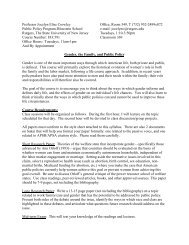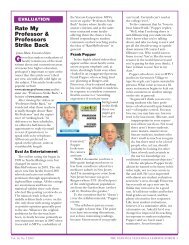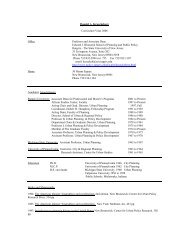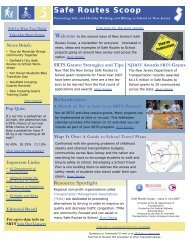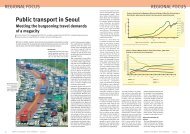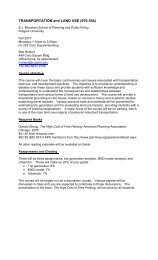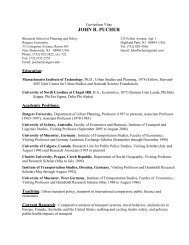methods II spring 13 Syllabus - Bloustein School of Planning and ...
methods II spring 13 Syllabus - Bloustein School of Planning and ...
methods II spring 13 Syllabus - Bloustein School of Planning and ...
You also want an ePaper? Increase the reach of your titles
YUMPU automatically turns print PDFs into web optimized ePapers that Google loves.
Rutgers, the State University <strong>of</strong> New Jersey<br />
<strong>Bloustein</strong> <strong>School</strong> <strong>of</strong> <strong>Planning</strong> <strong>and</strong> Public Policy<br />
34:833:630 METHODS <strong>II</strong><br />
Spring, 20<strong>13</strong><br />
Pr<strong>of</strong>essor: Andrea Hetling<br />
Office: Civic Square Building, 33 Livingston Avenue, Room 542<br />
E-mail: ahetling@rutgers.edu<br />
Office Hours: Mondays 11:00am - 2:00pm <strong>and</strong> by appointment<br />
Classroom: 33 Livingston Avenue, Civic Square Building, Room 253/ Comp Lab 372<br />
Class Hours: Wednesdays, 1:10 – 3:50<br />
Course Description <strong>and</strong> Teaching Style<br />
This course is an introduction to basic quantitative data analysis <strong>and</strong> is designed to help you<br />
develop the skills necessary to carry out elementary empirical analyses <strong>of</strong> policy issues. Methods<br />
I is a pre-requisite, <strong>and</strong> I will assume a mastery <strong>of</strong> the topics covered in that course. The main<br />
goal <strong>of</strong> Methods <strong>II</strong> is for you to learn to utilize statistics as an applied tool in researching policy<br />
issues <strong>and</strong> thus an underst<strong>and</strong>ing <strong>of</strong> research design is critical. We will cover the techniques <strong>and</strong><br />
language <strong>of</strong> descriptive <strong>and</strong> inferential statistics. We will cover bivariate <strong>and</strong> multivariate<br />
analyses with an introduction to multiple regression. You will write an original, empirical data<br />
analysis paper using a secondary data set that you must find. In addition to conducting analyses,<br />
we will discuss <strong>and</strong> interpret statistical results. This course will not make you into expert<br />
statisticians, but it will give you the skills to be educated consumers (<strong>and</strong> <strong>of</strong>ten critics) <strong>of</strong> the<br />
research <strong>of</strong> others <strong>and</strong> to continue your analytic studies in other classes if you so choose.<br />
The class meets meets weekly for 2 hours <strong>and</strong> 40 minutes. The format for the class lecture<br />
period will be lecture <strong>and</strong> facilitated discussion. I am a firm believer <strong>of</strong> active learning; thus, I<br />
will attempt to use discussion in place <strong>of</strong> traditional lectures whenever possible <strong>and</strong> encourage<br />
questions <strong>and</strong> expect class participation. We will also make use <strong>of</strong> the computer lab, <strong>of</strong>ten times<br />
meeting in the classroom first <strong>and</strong> then walking to the lab for the last hour <strong>of</strong> class. These lab<br />
sessions will allow you to gain some h<strong>and</strong>s-on practice with the concepts we learn in lecture.<br />
Course Objectives<br />
The goals <strong>of</strong> this course is to provide students with:<br />
1) An ability to conduct, interpret <strong>and</strong> present descriptive, inferential, <strong>and</strong> associative<br />
statistics<br />
2) The skill to use a statistical computer package - SPSS<br />
3) The foundation necessary continue your studies in quantitative analyses if you so choose
34:833:530 <strong>Syllabus</strong> Page 2 <strong>of</strong> 4<br />
Required Readings<br />
Mohr, Lawrence B. (1990). Underst<strong>and</strong>ing Significance Testing. Quantitative Applications in the<br />
Social Sciences # 57. Thous<strong>and</strong> Oaks, CA: Sage Publications.<br />
Pearson, Robert W. (2010). Statistical Persuasion. Thous<strong>and</strong> Oaks, CA: SAGE Publications.<br />
Schroeder, Larry D., Sjoquist, David L., & Stephan, Paula E. (1986). Underst<strong>and</strong>ing Regression<br />
Analysis: An Introductory Guide. Quantitative Applications in the Social Sciences # 57.<br />
Newbury Park, CA: Sage Publications.<br />
Books are available at the main Rutgers bookstore, in downtown New Brunswick.<br />
Additional readings will be posted as PDFs under the resources tab on the course Sakai site.<br />
Grading<br />
Numerical grades will be calculated on a simple percentage basis as follows:<br />
Midterm exam 20%<br />
Weekly homeworks 30%<br />
Class participation 5%<br />
Data analysis paper 15%<br />
Policy brief 10%<br />
Final exam 20%<br />
Total 100%<br />
Letter grades will be assigned as follows:<br />
90 to 100% = A; 86 to 89% = B+; 80 to 85% = B; 76 to 79% = C+<br />
70 to 75% = C; 60 to 69% = D; 0 to 59% = F<br />
Ground Rules<br />
Collegial <strong>and</strong> respectful conduct is expected in class. Class members should consider themselves<br />
colleagues who will collaborate to help each other develop a solid underst<strong>and</strong>ing <strong>of</strong> materials <strong>and</strong><br />
concepts. To facilitate this process <strong>and</strong> your learning, we will adhere to some basic rules:<br />
• Attendance at all class sessions is expected. You will be granted two absences without<br />
penalty. Any additional missed classes will count against your class participation grade.<br />
If you miss a class, you must use the University absence reporting website<br />
https://sims.rutgers.edu/ssra/ to indicate the date <strong>and</strong> reason for your absence. An email<br />
is automatically sent to me.<br />
• Class will start <strong>and</strong> end on time. Although I underst<strong>and</strong> emergencies occur, timely<br />
arrivals <strong>and</strong> departures should be the norm. Excessive <strong>and</strong>/or habitual lateness <strong>and</strong>/or<br />
early departures will count against your class participation grade.<br />
Last edited 12/14/12
34:833:530 <strong>Syllabus</strong> Page 3 <strong>of</strong> 4<br />
• Please turn <strong>of</strong>f (or silence <strong>and</strong> refrain from using) your cell phones <strong>and</strong> other electronic<br />
devices during class.<br />
• All assignments must be completed on time, typed in 12-point font, <strong>and</strong> submitted in hard<br />
copy in class. Late work will be penalized one-quarter <strong>of</strong> a letter grade daily. For<br />
example, an assignment submitted 4 days late will be docked an entire letter grade, e.g.,<br />
from a B+ to a C+. Assignments cannot be submitted any later than one week after the<br />
due date; missed assignments will receive a “0”.<br />
• Late submissions for the final paper <strong>and</strong> policy memo are not permitted. Exam make-ups<br />
are not permitted.<br />
• Cheating, plagiarism <strong>and</strong> other forms <strong>of</strong> academic dishonesty will not be tolerated. Please<br />
see the University’s Policy on Academic Integrity for Undergraduate <strong>and</strong> Graduate<br />
Students located on the web at http://ctaar.rutgers.edu/integrity/policy.html. You should<br />
also note that I use the Turnitin feature on Sakai to help me identify problems with<br />
plagiarism.<br />
• If any questions or concerns arise, please come see me! My <strong>of</strong>fice hours are listed on the<br />
top <strong>of</strong> the syllabus. If you cannot make my <strong>of</strong>fice hours, please make an appointment.<br />
Any student in this course who has a disability that may prevent him or her from fully<br />
demonstrating his or her abilities should contact me as soon as possible so we can discuss<br />
accommodations necessary to ensure full participation <strong>and</strong> to facilitate your educational<br />
opportunities.<br />
A Few Words to the Wise<br />
• Come to class prepared! Complete readings prior to lecture.<br />
• Seek help early! Don’t wait till the last minute if you are having difficulties.<br />
• Get missed notes from a classmate! I will not hold individual meetings to provide<br />
summaries or repeat class material.<br />
Last edited 12/14/12
34:833:530 <strong>Syllabus</strong> Page 4 <strong>of</strong> 4<br />
Schedule<br />
Date Topic Readings <strong>and</strong> Assignments<br />
1/23 Introductions <strong>and</strong> course overview;<br />
Statistics in policy; Research ethics<br />
1/30 SPSS review (Including review <strong>of</strong><br />
descriptive statistics)<br />
Normal curve <strong>and</strong> inferential statistics<br />
2/6 Estimation <strong>and</strong> confidence intervals<br />
2/<strong>13</strong> Hypothesis testing – one sample <strong>and</strong><br />
two samples<br />
2/20 Hypothesis testing –ANOVA<br />
Exam Review<br />
2/27 EXAM<br />
3/6 Secondary data<br />
Bivariate association – review<br />
Hypothesis testing – chi-square<br />
3/<strong>13</strong> Elaborating bivariate tables<br />
Writing about numbers<br />
3/20 SPRING BREAK<br />
3/27 Bivariate association – choosing a<br />
statistic - nominal <strong>and</strong> ordinal levels<br />
Last edited 12/14/12<br />
(Review Pearson, Chapters 1, 3, 5 &<br />
6)<br />
Pearson, Chapter 5, pp. 1<strong>13</strong>-121<br />
Urdan, Chapters 4 & 5 (pdf on Sakai)<br />
HW 1 due<br />
Pearson, Chapter 8<br />
Mohr, pp 1-27<br />
Vickers, Chapter 11 (pdf on Sakai)<br />
HW 2 due<br />
Vickers, Chapter 14 (pdf on Sakai)<br />
Mohr, pp. (28-49) 49-74<br />
Pearson, Chapter 9, pp. 207-215<br />
HW 3 due<br />
Pearson, Chapter 9, pp. 215-228<br />
Urdan, Chapter 10 (pdf on Sakai)<br />
HW 4 due<br />
Pearson, Chapters 7 <strong>and</strong> 4<br />
Urdan, Chapter 14 (pdf on Sakai)<br />
TBA (pdf on Sakai)<br />
Pearson, Chapter 14<br />
HW 5 due<br />
Pearson, Chapter 10, pp.22-240<br />
HW 6 due<br />
4/3 Correlations <strong>and</strong> Linear regression Pearson, Chapter 10, pp. 240-252 &<br />
Chapter 11<br />
Data analysis paper due<br />
4/10 Multiple regression – assumptions <strong>and</strong> Pearson, Chapter 12<br />
violations<br />
HW 7 due<br />
4/17 Dummy variables <strong>and</strong> interactions Schroeder, Sjoquist, & Stephan<br />
Policy briefs due<br />
4/24 Other models Vickers, Chapter 18<br />
Pearson, Chapter <strong>13</strong><br />
TBA (pdf on Sakai)<br />
HW 8 due<br />
5/1 Discussion/presentation <strong>of</strong> papers<br />
Review<br />
TBA FINAL EXAM



